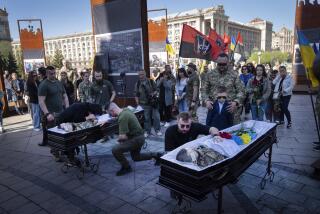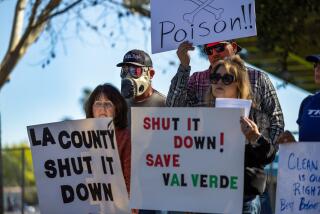Manager says safety issues are ignored at Hanford nuclear site
The long-troubled project to clean up radioactive waste in Hanford, Wash., has come under attack from another senior manager, the third to assert that top executives are ignoring serious problems in the plant’s design.
Donna Busche, the manager of environmental and nuclear safety for San Francisco-based URS Corp., alleged in a lawsuit filed Tuesday that executives at the $13.4-billion project attempted to suppress her warnings and were working to fire her.
Busche, a nuclear engineer and health physicist, alleged that pressure to meet deadlines led the company to retaliate against her for insisting on stringent safety practices at the former nuclear weapons complex.
Hanford is the nation’s most contaminated piece of property, home to 56 million gallons of highly radioactive sludge in underground tanks that pose a long-term risk of leaking into the Columbia River. Dozens of the tanks are already leaking and threatening the largest river in the western U.S.
The Energy Department is in a race to pump out the waste, embed it into glass and ship it to a future dump, but so far not a single gallon has been treated and the project is more than 20 years behind the original schedule.
Construction has been stopped since last year over allegations that the plant’s design for mixing radioactive waste could allow explosive hydrogen gas to detonate inside the plant, or allow enough radioactive solids to accumulate in tanks to trigger nuclear fission.
The concerns, backed up by panels of outside experts, forced the plant’s construction contractors, URS and San Francisco-based Bechtel, to begin a full-scale test of the system to mix the sludge, but using nonradioactive surrogates.
The concerns about the Hanford waste treatment plant — which resembles a small industrial city with many individual processing plants, laboratories and ancillary buildings — have been voiced by senior officials on the project.
Walter Tamosaitis, a senior URS scientist and manager of a large research staff, has said his warnings about potential hydrogen gas explosions led to his being isolated at work, given no assignments and put in a basement office without furniture.
In August, Gary Brunson, then the Energy Department’s engineering division director, sent a memo to higher-level officials that alleged 34 instances in which Bechtel had committed factual errors, pursued unsafe designs or provided equipment that did not meet federal standards. Brunson said those failures had led to delays and increased costs and that the Energy Department should remove Bechtel as the design authority for the plant.
After the Brunson memo, an investigation by the Energy Department’s office of nuclear safety found in November that Bechtel had committed potential health and safety violations, a finding that could lead to a multimillion-dollar fine.
This month, the Government Accountability Office said the success of the entire Hanford project hinged on finding solutions to a wide range of technical problems. The report noted that the cost had jumped to $13.4 billion from $12.3 billion, and would probably increase further.
Busche’s suit named URS Energy and Construction and Bechtel National. A spokeswoman for URS said the company would not comment on Busche’s allegations as a matter of policy on litigation. Busche had earlier filed a whistle-blower complaint with the Labor Department, but elevated the dispute to a formal lawsuit Tuesday when she filed the suit in federal court in Spokane, Wash.
Bechtel National, the lead contractor at the Hanford project, said it took concerns about safety seriously and did not tolerate retaliation or harassment against employees who raised them.
“We have thoroughly reviewed Ms. Busche’s complaint and found no basis for it,” the company said in a statement. “We remain committed to ensuring that [the waste treatment plant’s] nuclear safety and quality culture is strong.”
But Tom Carpenter, executive director of the watchdog group Hanford Challenge, said the allegations raised by Busche, Tamosaitis and Brunson demonstrated the depth of the problems affecting the stalled project.
“Congress needs to take a hard look at the situation here and determine whether we can go forward,” Carpenter said Wednesday.
In an interview, Busche said one of her biggest technical fights involves a risk-analysis tool that URS and Bechtel want to use to assess the potential for hydrogen explosions inside the plant’s piping systems. Busche said the tool would allow tens of thousands of safety components to be removed from the design if it predicted the risk of an explosion as being extremely small.
She said the standard approach to safety design requires no possibility of an explosion that would release radioactivity.
“I’m holding the line on that one,” she said.
The suit refers to that dispute, which surfaced at a lengthy hearing conducted in 2010 by the Defense Nuclear Facilities Safety Board, an independent federal agency. During days of testimony, Busche was often at odds with officials from her own company and the Energy Department. In her lawsuit, Busche said that URS and Bechtel officials had privately asked whether she could alter her testimony and she refused.
The safety board apparently knew that she was under pressure. During the hearings, a safety board member asked whether she was up to the pressure that was likely to be applied to her, apparently not knowing her assertions that she was already being asked to change her testimony. She assured the board she was capable of withstanding the pressure, according to a transcript of the safety board hearing.
In the aftermath of the hearings, URS officials told her to stop putting her safety concerns in writing, she claims in the suit, and Bechtel “actively sabotaged her work.”
More to Read
Start your day right
Sign up for Essential California for news, features and recommendations from the L.A. Times and beyond in your inbox six days a week.
You may occasionally receive promotional content from the Los Angeles Times.







